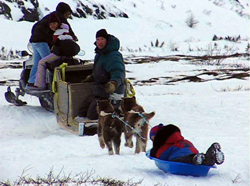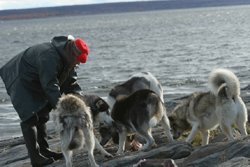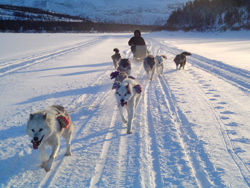In This Issue....
Sledge Dog Memorial Fund Update
Product Review: Collasate™/EMT™
Index of articles by subject
Index of back issues by volume number
Search The Fan Hitch
Articles to download and print
Ordering Ken MacRury's Thesis
Our comprehensive list of resources
Talk to The Fan Hitch
The Fan Hitch home page
ISDI home page
Editor's/Publisher's Statement
Editor: Sue Hamilton
Webmaster: Mark Hamilton
The Fan Hitch welcomes your letters, stories, comments and suggestions. The editorial staff reserves the right to edit submissions used for publication.
Contents of The Fan Hitch are protected by international copyright laws. No photo, drawing or text may be reproduced in any form without written consent. Webmasters please note: written consent is necessary before linking this site to yours! Please forward requests to Sue Hamilton, 55 Town Line Rd., Harwinton, Connecticut 06791, USA or mail@thefanhitch.org.
This site is dedicated to the Inuit Dog as well as related Inuit culture and traditions. It is also home to The Fan Hitch, Journal of the Inuit Sled Dog.

As his father, Mark, attentively watches from the back of the
qamutiq, Imaapik Brazeau, age three, enjoys the musher's view.
Expertly driving the snowmachine is Mark's daughter, thirteen-
year-old Heather-Rose Etok. Heather-Rose's cousin, Uttuqi
Hubloo, age twelve, rides behind her. h photo: Hamilton
That Was Then, This is Now
by Sue Hamilton
In the March, 2005 issue of The Fan Hitch, readers were introduced to a movement to restore the pure Inuit Sled Dog to Nunavik. This milestone project was described in the F.I.D.O. of Allen Gordon of Kuujjuaq. In the December, 2005 issue, two more F.I.D.O.s, Daniel Annanack and Mark Brazeau, both of neighboring Kangiqsualujjuaq, described the initiation of that community's program to recover the breed. All of this news has been encouraging, exciting and promising.
Thirty-two years prior to these announcements, two men embarked on a similar journey centered in Yellowknife, NWT. Bill Carpenter and John McGrath undertook their plan to snatch the Inuit Sled Dog, then commonly referred to as the Eskimo Dog, from the brink of extinction. The two eras and venues were quite different. One motivation carried a sense of urgency, the other more a sense of tradition. This article is not intended to measure one effort against the other. In many respects the focus of social, economic and political issues has shifted. Personal circumstances differ and priorities change. Instead of comparing and contrasting the two efforts, it can be said that without question they shared a mutual sentiment, a passion for the breed and a desire to see it endure as the working dog of the North.
There are few outsiders who have had an insider's experience with either endeavor. Those breed enthusiasts on the periphery read of these events and feel gratitude for the past efforts and delight in and hope for the current ones. However, most of us are not aware of the nitty-gritty of day-to-day, month-to-month, year-to-year highs and lows, successes and challenges of those involved in both eras.
Other than a few first hand accounts and some secondhand anecdotes, I cannot personally speak to what all took place during the 1970s and 1980s. Regretfully (very regretfully), I was myopically focused on my own misguided lost cause - the Alaskan Malamute. Fortunately, having established several years ago a free-flowing long distance dialogue with the folks in Nunavik and having had the good fortune to have visited both Kuujjuaq and Kangiqsualujjuaq this past April, I have a much better appreciation for the trials, tribulations and triumphs of these twenty-first century endeavors to secure the future of the Inuit Sled Dog. The men involved may have unique personal reasons for their commitment, but they share dedication and vitality. These attributes, as well as mutual encouragement, help sustain them during the inevitable low periods which accompany all great undertakings. In addition to their professions, they all wear many other hats, bearing huge responsibilities to their communities. They are devoted to their families. Their days are "36 hours" and their weeks "10 days" long, and even that is not long enough. Yet they even find time to contribute to The Fan Hitch. And they are driven to be not just dog owners but great dog men. They are determined to do this job and do it well.

Allen Gordon feeds his dogs country food
a their summer
residence, a nearby
island.
photo:
Wittenborn
Indeed, they have advanced despite many challenges. They began their collective journey facing initial skepticism, a shortfall of support, and some very devious and mean-spirited meddling from a few owner-breeders outside of the region who, instead of being an honest part of a solution, preferred to be part of a problem. It was all reminiscent of Christopher Columbus being mocked for believing the world was round when the "great thinkers" of the period insisted it was flat. And while they are still wrestling with their own bureaucracies, even having to suffer the indignation of defending cultural rights and the manner of harvesting traditional food for their dogs to unenlightened officials, like Columbus, these modern pioneers are proving wrong the doubters and obstructionists. They are working hard to see that their dogs' gene pool is diversified. They are producing litters of fine working stock. They have caught the attention of mainstream media well outside their region and, even more important, they are rekindling the consciousness of Nunavimiut - young and old alike - regarding an integral part of their cultural history. This can be seen, for example, in Chapter 1 in Québec Roots: The Place Where I Live 2007 (Blue Metropolis Foundation, ISBN 978-2-923319-02-5). Written by students from the Ulluriaq School, it is all about the past, present and future of mushing in the region. Elders are talking about the dogs of their youth and today's youth are talking about developing their own teams, some realizing these dreams.
Why did I write this? Having visited these men - these whirling dervishes - in their communities, having observed their daily routines, and their seemingly limitless energy and spirit with which the take on all their challenges, I stand in awe of what they do, how much they have been able to accomplish. I think merely saying that there is a movement in Nunavik to restore the pure Inuit Sled Dog glosses over, perhaps even trivializes, just how much blood, sweat and tears is being expended into their programs. I would not wish for the rest of the world's awareness of what they are doing to be summarized in a mere sound bite. That's like abridging the course of World War II by simply saying, "The Allies won it."
This article comes with no expectations, although I believe there is always a means and a role for everyone at every level to play - such as expressing words of encouragement for all the Allens, Marks and Daniels, or establishing permanent veterinary service for the region, something sorely lacking, very much desired and needed, yet mystifyingly absent.
If ever there was a group of folks worthy of having their story told and who deserves "smooth ice and narrow leads" on their journey, here they are.

Daniel Annanack and his
team photo: Brazeau